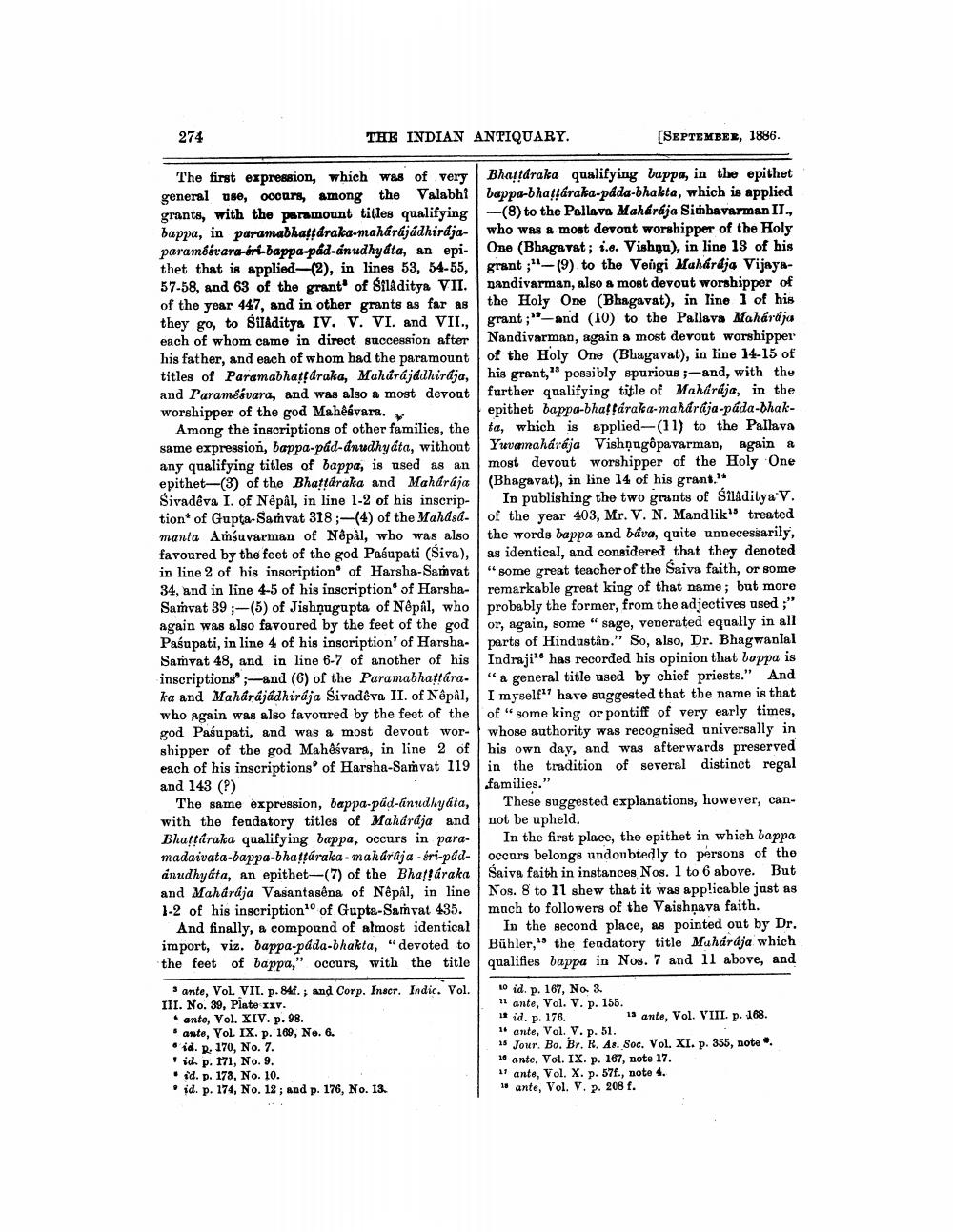________________
274
THE INDIAN ANTIQUARY.
[SEPTEMBEE, 1886.
The first expression, which was of very Bhattáraka qualifying bappa, in the epithet general use, occurs, among the Valabhi bappa-bhatjáraka-pada-bhakta, which is applied grants, with the paramount titles qualifying -(8) to the Pallava Maharaja Simbavarman II., bappa, in paramabhaftdraka-mahárájádhirdja- who was a most devout worshipper of the Holy paraméérara-árf-bappa-pád-ánudhydta, an epi- One (Bhagavat; i.e. Vishnu), in line 13 of his thet that is applied (2), in lines 53, 54-55, grant ;"-(9) to the Veigi Mahardja Vijaya57-58, and 63 of the grant of SilAditya VII. nandivarman, also a most devout worshipper of of the year 447, and in other grants as far as the Holy One (Bhagavat), in line 1 of his they go, to SilAditya IV. V. VI. and VII., grant;"-and (10) to the Pallava Maharaja each of whom came in direct succession after Nandivarman, again a most devout worshipper his father, and each of whom had the paramount of the Holy One (Bhagavat), in line 14-15 of titles of Paramabhatfaraka, Maharajadhirdja, his grant," possibly spurious ;-and, with the and Paramésvara, and was also a most devout further qualifying title of Mahúrája, in the worshipper of the god Maheśvara.
epithet bappa-bhattáraka-mahárája-pada-DhakAmong the inscriptions of other families, the ta, which is applied-(11) to the Pallava same expression, bappa-pad-ánudhyata, without Yuvamaharaja Vishnugôpavarman, again a any qualifying titles of bappa, is used as an most devout worshipper of the Holy One epithet-(3) of the Bhattáraka and Maharaja (Bhagavat), in line 14 of his grant." Sivadêva I. of Nepal, in line 1-2 of his inscrip- In publishing the two grants of Siladitya V. tion of Gupta-Samvat 318;-(4) of the Mahásá- of the year 403, Mr. V. N. Mandlik" treated manta Amíuvarman of Nepal, who was also the words bappa and bava, quite unnecessarily, favoured by the feet of the god Pasupati (Śiva), as identical, and considered that they denoted in line 2 of his inscription of Harsha-Samvat " some great teacher of the Saiva faith, or some 34, and in line 4-5 of his inscription of Harsha- remarkable great king of that name; but more Samvat 39 ;-(5) of Jishņugupta of Nepal, who probably the former, from the adjectives used;" again was also favoured by the feet of the god or, again, some "sage, venerated equally in all Pasupati, in line 4 of his inscription' of Harsha- parts of Hindustan." So, also, Dr. Bhagwanlal Samvat 48, and in line 6-7 of another of his Indraji has recorded his opinion that boppa is inscriptions; and (6) of the Paramabhattara. "a general title used by chief priests." And ka and Mahárájádhiraja Sivadêva II. of Nepal, I myself have suggested that the name is that who again was also favoured by the feet of the of "some king or pontiff of very early times, god Pasupati, and was a most devout wor-whose authority was recognised universally in shipper of the god Mahêśvara, in line 2 of his own day, and was afterwards preserved each of his inscriptions of Harsha-Samvat 119 in the tradition of several distinct regal and 143 )
families." The same expression, bappa-pád-kinudlyáta, These suggested explanations, however, canwith the fendatory titles of Mahdrája and not be upheld. Bhattaraka qualifying bappa, occurs in para- In the first place, the epithet in which bappa madaivata-bappa bhattáraka-maharaja - Sri-pad- occurs belongs undoubtedly to persons of tho ánudhyata, an epithet-(7) of the Bha! áraka Saiva faith in instances Nos. 1 to 6 above. But and Mahárúja Vasantasena of Nepal, in line Nos. 8 to 11 shew that it was applicable just as 1-2 of his inscription of Gupta-Samvat 435. mach to followers of the Vaishnava faith.
And finally, a compound of almost identical In the second place, as pointed out by Dr. import, viz. bappa-pada-bhakta, "devoted to Bühler," the feadatory title Muhárája which the feet of bappa," occurs, with the title qualifies bappa in Nos. 7 and 11 above, and
anto, VoL VII. p. 84., and Corp. Inaer. Indie. Vol. 10 id. p. 167, No 3. III. No. 39, Plate Iiv.
11 ante, Vol. V. p. 155. ante, Vol. XIV. p. 98.
13 ante, Vol. VIIL p. 168. . ante, Vol. IX. p. 109, No. 6.
1. ante, Vol. V. p. 51. • id. R. 170, No. 7.
15 Jour. Bo. Br. R. As. Soc. Vol. XI. p. 355, notes id. p. 171, No. 9.
18 ante, Vol. IX. p. 167, note 17. id. p. 178, No. 10.
11 ante, Vol. X. p. 57f., note 4. id. p. 174, No. 12; and p. 176, No. 13.
15 ante, Vol. V. 2. 208 f.




